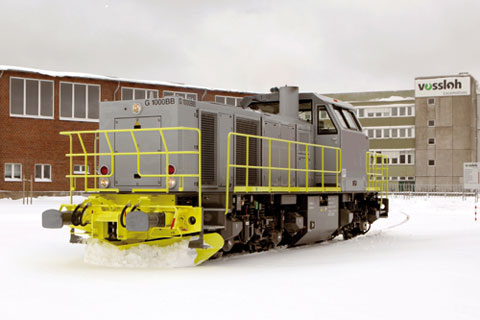Since 1923, railway vehicles have been built with internal combustion engines, with diesel engines supplied by various manufacturers such as Cummins, CAT or MTU, in accordance with the customer’s requirements. Vossloh Locomotives GmbH, which developed from the traditional Krupp-MaK, has achieved its leading position in diesel locomotives through experience, competence and consistent further development. Whether for state, private or industry railways, whether for standard execution or for tailor-made locomotives, the traditional company has consistently offered solutions which meet its customers’ needs. The product portfolio includes diesel-hydraulic and diesel-electric models. As an alternative to the purchase of new vehicles, it also refits existing locomotives. In addition, the company develops, builds and produces motorised bogies, compressed air systems and components for cooling and ventilation systems. At the Moers location, Vossloh Locomotives provides a full maintenance, repair and modernisation service for locomotives. More than 80 employees work at the service centre there, of whom more than half in the workshops. The customer delivers the locomotives. Whether the locomotives are towed to Moers or travel under their own steam depends on the transport costs and their condition. For maintenance and repair works, specially trained fitters travel all over Europe. Whether in Athens or in Narvik and Kiruna in the far North, mobile repairs and maintenance work can be executed everywhere.
Regular and thorough inspections are a must for every locomotive. Diesel-electric DE 2700s undergo an inspection every 500 hours of operation or every 4-6 weeks. If the oil has not shown conspicuous features during the oil analyses carried out at the time, then the oil and injectors are replaced after 3,000 hours of operation in each case. The diesel-hydraulic models are subjected to an inspection approximately after every 1,000 hours of operation, according to a fixed maintenance plan. A major part of the engine maintenance is carried out by the respective engine manufacturer or by their certified partner workshops.

In selecting lubricants, the rules and approvals of the respective engine manufacturers should be observed, above all for the engine oil. The diesel engines may range from four-cylinder in-line engines in smaller models to heavy goods and express train locomotives with 16-cylinder V engines. The power produced by the engine is transmitted hydraulically or electrically to the wheel sets. Gears in turn sit on the wheel sets, which must be supplied with gear oils. Nor should we forget radiator antifreeze or greases for the bearings or the wheel flange lubrication. Depending on the operator of the locomotive, it is not always the approval of the component manufacturer or recommendations by Vossloh which is decisive for the choice of lubricant, but also that of the railway company. For example, at its competence centre, Deutsche Bahn AG classifies lubricants into three grades, Q1 to Q3. Q1 stands for the highest quality grade. An approval or listing in the maintenance documents of Deutsche Bahn AG Systemtechnik is regarded as a practice-oriented guideline. It is also used as a guideline by many other railway companies.
Hence, not only the choice of lubricant plays an important role but also its monitoring in practice. In order, e.g. to check the perfect condition of the oil and of the engine, the technicians of Vossloh Locomotives use OELCHECK lubricant analyses. In each case, after 500 hours of operation, a used oil sample from the engine is investigated. The oil analysis is thus a fixed component of engine maintenance. In addition, gear oils and other lubricants are analysed to clarify causes of damage.
Vossloh locomotives are well-known for their efficiency and reliability. Lastly, they must perform their service in wind and bad weather and sometimes under the most extreme operating conditions. Even at temperatures as low as -40°C during the icy Norwegian winter, there can be no malfunctions. If there are no third party supplies of thermal heat available at such low temperatures during stoppages or even for the whole night, the locomotive engines continue running while stationary. In this way, at least the cooling water of the locomotive warms the carriages. This can nevertheless cause problems in many types of engine, since this measure prevents the cooling of the train. But with incomplete combustion of the diesel fuel under no-load running operation of the cooled engine, unburnt diesel and condensate can get into the engine oil. For regular driving with engine oil temperatures of over 60°C, water and fuel begin to evaporate and vaporise. There is nevertheless a residual risk to the engine, which may only be excluded through regular oil analyses with the precise determination of the water and fuel content of the oil.
In addition to the problems arising from water and diesel condensates, at low temperatures, oil and fuel vapour from the crankcase breather may collect in the loading air shaft. If power is then connected, these vapours can cause the engine to self-accelerate in uncontrolled fashion and thus „run away“. Not least, by virtue of the oil analyses, Vossloh Locomotives has also developed solutions for such low-temperature problems: for example, for the DE 2700, an electric preheating system is built into the engine as a standard feature. In addition, as a prudent measure, more and more locomotives are equipped with an auxiliary diesel engine. Beside the preheating of the cooling water and the fuel, it at the same time guarantees the trickle charging of the on-board batteries. Correspondingly equipped and monitored by OELCHECK with regular lubricant analyses, the locomotives from Kiel always reach their destinations safely, wherever they may be and even at the lowest temperatures.
related links
